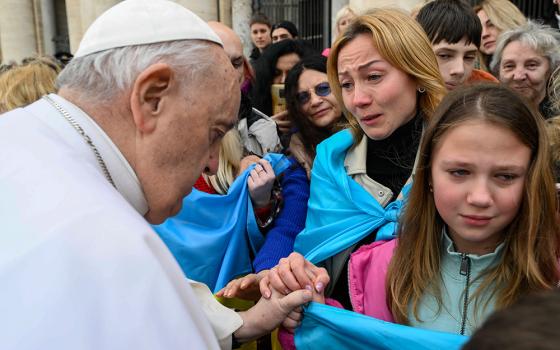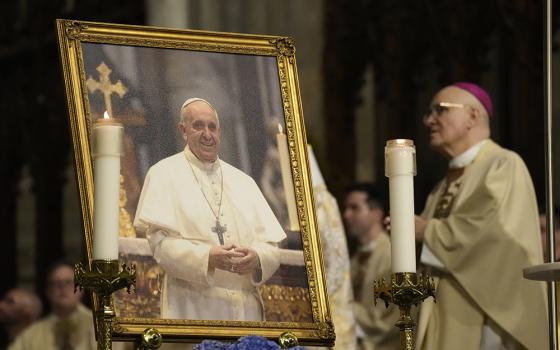I first became acquainted with the writings of Tracey Rowland in the pages of the Tablet, where she is a fairly regular contributor. I am not sure why I did not see her book “Ratzinger’s Faith” when it was published by Oxford Press in 2008. But, I saw it at a local bookstore this past winter, bought it, and put it on my list of books to read. I completed it last weekend and highly recommend it to anyone interested in learning more about the theological pedigree and distinctive theological perspectives of Joseph Ratzinger, now Pope Benedict XVI.
The first casualty of Rowland’s scholarship is the meme – let us be frank, a meme that has more than a little currency in leftie Catholic circles – that Joseph Ratzinger may have been on the side of the reformers at Vatican II, where he served as a peritus to Cardinal Frings of Cologne, but that after Vatican II, with the social and religious tumult of 1968, he turned hard to the right and has essentially been trying to put the Vatican II toothpaste back into the tube ever since, leading the Church back into pre-conciliar days. Rowland points us towards several instances in which Ratzinger has made his criticism of pre-conciliar scholasticism quite clear. He has allowed that it has its excellences but that he always found it dry and impersonal. She quotes a seminary Prefect who knew Ratzinger as a student who relates this observation, at once charming and profound: “[According to Raztinger] God is not recognized because He is a summum bonum that is able to be grasped and demonstrated with exact formulas, but because He is a You who comes forward and gets Himself recognized…In the dialect of Bavaria we would say: it[scholasticism] wasn’t his beer….He’s not interested in defining God by abstract concepts. An abstraction – he once told me – doesn’t need a mother.” Rowland relates throughout the book how Raztinger has stayed true to his suspicions of pre-conciliar scholasticism.
The second casualty of Rowland’s scholarship, again offered early in the book but sustained throughout its pages, is the idea that Ratzinger’s Augustinianism is “the problem” and that this characteristic differentiates him from the upbeat mood of the Council: Whereas the Council was opening the windows of the Church to the world, Raztinger has been trying to shut them ever since. She writes:
Well said. I would add that Ratzinger, like John Paul II, understandably and rightly has a certain suspicion, not to say pessimism, about modern culture’s ability to seek the good, and it has nothing to do with their reading of Augustine. Both men grew up in the horror of World War II.
The first chapter of Rowland’s book presents a very fine survey of the pre-conciliar theological landscape, how the Council absorbed the different theological streams that fed it documents, and some of the emerging post-conciliar schools of thought, how they overlap and how they don’t. She notes how pre-conciliar Thomism fostered a “two-tier” approach to the relationship between grace and nature, and that this two-tier approach, or dualism, unintentionally fostered the secularization of culture. She notes that this two-tier approach was especially adopted by Catholic scholars in Protestant countries, such as the U.S., in their efforts to build bridges between Catholics and non-Catholics. “The idea was that Catholics and non-Catholics could find common ground on the territory of ‘pure nature’, while the more socially contentious supernatural beliefs and aspirations of Catholics could be relegated to the privacy of the individual soul.” She quotes Henri de Lubac who, on a tour of the U.S. in 1968 had warned that such a construction of the relationship between grace and nature resulted in “a total secularization that would banish God not only from social life but from culture and even from relationships in private life.”
This debate about the relationship between nature and grace may seem like the stuff, exclusively, of theological symposia. Instead, it is the heart of the matter. The influence of de Lubac and Balthasar on both John Paul II and Benedict XVI, I would submit although Rowland does not, is precisely the part of both men’s thought that Catholic neo-cons like George Weigel, Richard John Neuhaus, and Michael Novak were never able to grasp, or were afraid to grasp. How could they, committed as they were to John Courtney Murray’s attempts to reconcile the theological constitution of the Church with the Constitution of the United States. It was Murray, after all, who once wrote that “the dualism of mankind’s two hierarchically ordered forms of social life has been Christianity’s cardinal contribution to the Western political tradition.” It is all very well and good to repeat the words of Jesus about rendering unto Caesar the things that are Caesar’s and rendering unto God the things that are God’s, but what if everything is God’s? One of the difficulties some of us have seen in the USCCB’s statements about religious liberty is precisely the way those statements embody the Murray approach. This is what Professor Schindler was getting at in his brilliant essay on that subject to which I earlier called readers’ attention here.
It would be going too far to say that the struggle between liberals and conservatives over the interpretation of the Council has been a sideshow. It is not going too far to recognize that there is a certain symbiotic relationship between the two that misses the more interesting struggle within Catholic theology. As Balthasar once wrote: “[The] program of Christian progressivism is curiously close to that of its opponent, Christian integralism…Both, ultimately, have reduced the problem of power between God and the world, between grace and nature, to a monistic form which is easy to handle and can be managed by men.” Liberals and conservatives may be fighting over the rules, but the de Lubac, Balthasar, Ratzinger project is to go deeper, and to assert, boldly, that for the Christian, the absolute imperative is love, not obedience, except and only insofar as love entails a type of obedience, a demanding obedience indeed, to its own dictates. Rowland is careful to note that many post-conciliar Thomists has been wrestling with this issue of grace and nature, and the problems of dualism, whether that dualism is attributed to mis-readings of Thomas by pre-conciliar thinkers, or to Cajetan, or to Thomas himself. It is the most fascinating theological issue of our time.
The different approaches towards the relationship between grace and nature profoundly affect how one reads the Council, especially Gaudium et Spes, and also how one views our understanding of Revelation, Scripture and Tradition. We shall take up these issues tomorrow.




